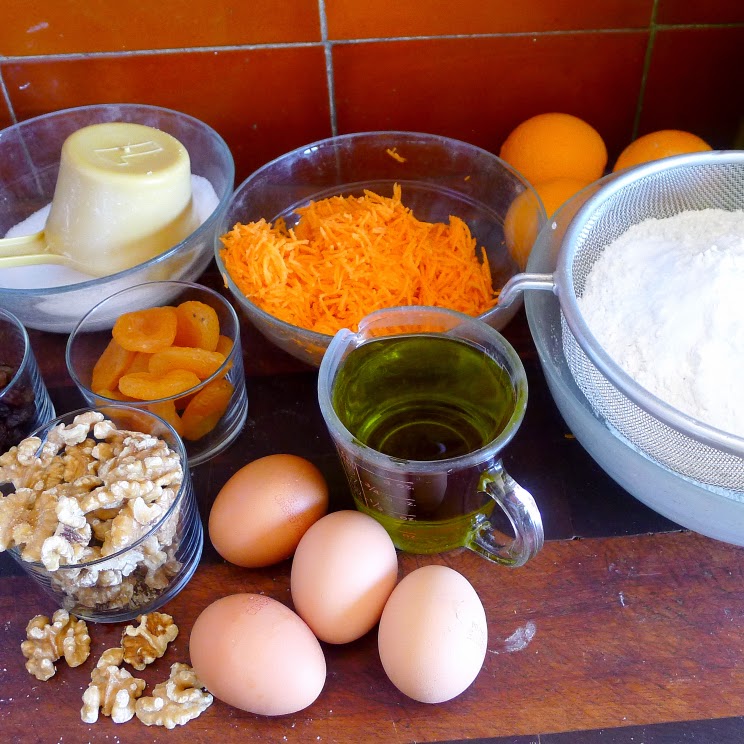While browsing the produce section at HiperCor (grocery section of El Corte Inglés department store), I overheard a customer inquire, “¿Donde están las zanahorias de Conil?” Where are the carrots from Conil. Since when do carrots have place names?
Conil de la Frontera is a town in Cádiz province, on the Atlantic coast, better known for tuna and for its fabulous beaches. But, apparently, market gardens thrive there too and carrots are a star product.
Carrots are no big deal in Spanish cooking. Sure, you need a fat, aromatic carrot in the puchero (soup pot), but nobody actually eats it. As a main ingredient or even a side dish? Not so much. This dish is an exception to the Spanish "carrots-bleh" attitude.
 |
| Fresh mint. |
 |
| Baby carrot from my garden. Will they ever grow big? |
My mother had a carrot joke that she used to tell little kids. The kids never got the joke, but she loved to tell it anyway. I tried it out on my grandson (when he was only eight) and he howled with laughter.
So, Mama Rabbit, Papa Rabbit and Baby Rabbit were having a field day in Mr. MacGregor’s garden, sampling the lettuces and carrots. Mama Rabbit chomped on a great big carrot. “Papa Rabbit,” she said, disapprovingly “this carrot is pithy.” The youngun piped up, “It should be, I just pithed on it!”
Minted Carrot Salad
Ensalada de Zanahorias con Hierbabuena
Ensalada de Zanahorias con Hierbabuena
 |
| Marinated carrots with raisins, almonds and fresh mint. |
This carrot dish can be served hot, cold or room temperature. It can be prepared and served immediately or left to marinate, refrigerated, overnight. In any case, chop the fresh mint and add to the carrots immediately before serving.
Serves 6 as a salad or side dish.
Serves 6 as a salad or side dish.
1 pound carrots (about 5), peeled and sliced thinly
1 tablespoon olive oil
1 tablespoon pine nuts or slivered almonds
1 tablespoon chopped spring onion
2 cloves garlic, chopped
1/8 teaspoon cumin
1 tablespoon raisins
1 tablespoon Sherry vinegar
½ teaspoon salt
Freshly ground black pepper
2 tablespoons chopped fresh mint leaves
1 tablespoon olive oil
1 tablespoon pine nuts or slivered almonds
1 tablespoon chopped spring onion
2 cloves garlic, chopped
1/8 teaspoon cumin
1 tablespoon raisins
1 tablespoon Sherry vinegar
½ teaspoon salt
Freshly ground black pepper
2 tablespoons chopped fresh mint leaves
Salad greens, if desired
Cook the carrots in boiling salted water until just tender, about 5 minutes. Drain and refresh in cold water. Drain.
In a small skillet heat the oil and fry the pine nuts or almonds until they are lightly toasted. Skim them out and reserve. Sauté the onion and garlic for 2 minutes. Stir in the cumin and raisins.
Add the sautéed onions and raisins to the carrots with the pine nuts, vinegar, salt and pepper. Toss to combine.
Stir in the chopped mint immediately before serving. Serve with salad greens, if desired.
Cook the carrots in boiling salted water until just tender, about 5 minutes. Drain and refresh in cold water. Drain.
In a small skillet heat the oil and fry the pine nuts or almonds until they are lightly toasted. Skim them out and reserve. Sauté the onion and garlic for 2 minutes. Stir in the cumin and raisins.
Add the sautéed onions and raisins to the carrots with the pine nuts, vinegar, salt and pepper. Toss to combine.
Stir in the chopped mint immediately before serving. Serve with salad greens, if desired.
 |
| Carrot salad for spring. Those are chive flowers in the photo. |























